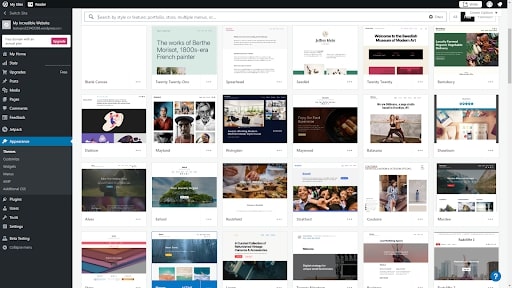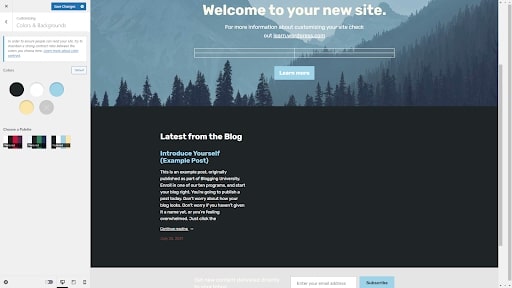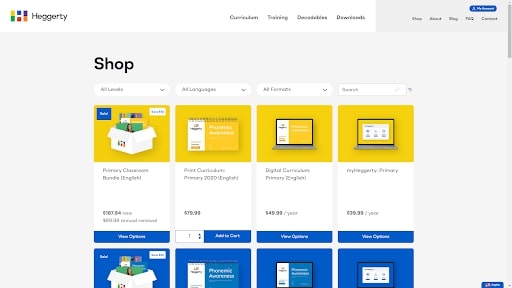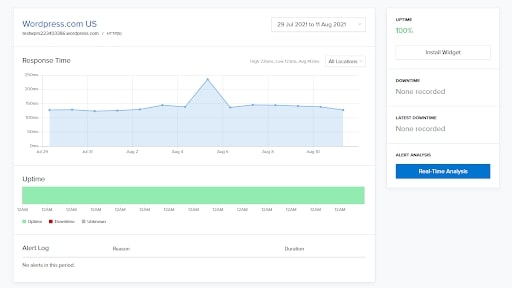Tom's Guide Verdict
WordPress.com offers an easy way to get a WordPress website, and the performance is excellent, but it has a steeper learning curve than other website builders.
Pros
- +
Massive list of potential themes
- +
Good performance
- +
Top blogging features
Cons
- -
Expensive for ecommerce
- -
Complex editor
Why you can trust Tom's Guide
WordPress is the world’s most popular CMS, powering around 42% of all websites online today. One of the simplest ways to start a WordPress website of your own is to get WordPress hosting at WordPress.com, and it rivals the best website builders while also able to be hosted by the best web hosting services.
You can use WordPress.com to get a website, and rarely have to worry about things like setting up software, system upgrades, security patches, and ongoing maintenance. In our WordPress review, we evaluate WordPress.com against the available today, so that you can decide whether it’s the best place to build your website.
WordPress review: Snapshot
WordPress.com’s offerings go from generous entry-level plans right up to powerful, expensive ecommerce plans. It has fast response times and 24/7 live chat support, making it a solid choice for hosting a WordPress website. There’s a massive list of themes and plugins to choose from, so it’s possible to make just about any kind of website with WordPress.com.
This high level of control unfortunately means WordPress.com is relatively cumbersome to use, and there’s little hand-holding for those who haven’t used WordPress before. Wix is a better choice for tech beginners, as it has the most intuitive interface, and Squarespace has better designs out of the box.
Score: 3.5/5
Read the full review below.
WordPress.com's competitors
| Header Cell - Column 0 | WordPress.com | Wix | Squarespace |
|---|---|---|---|
| Score | 3.5/5 | 4.5/5 | 4/5 |
| Pros | Thousands of templates - Fast site speeds - Easily swap themes | Intuitive website editor - Big list of template designs - Top customer support | Slick templates - Responsive designs - Great blogging tools |
| Cons | Expensive ecommerce plans - Steeper learning curve | Sites often require tweaking for mobile - Limited navigation menu options | No free plan - Can’t switch templates |
| Verdict | Best option for blog-focused websites | Best website builder if you have a particular design in mind | Best option for image-heavy websites |
| View deals | Visit site | Visit site | Visit site |
WordPress: Key features
There’s an important difference between WordPress.com and WordPress.org. WordPress.org is where you’ll find the open-source CMS software WordPress that can be installed on your choice of web hosting.
Get instant access to breaking news, the hottest reviews, great deals and helpful tips.
WordPress.com has more in common with website builders like Wix and Squarespace. It doesn’t offer every WordPress CMS feature, but makes it easy to quickly build a WordPress site. You don’t have to worry about installation and ongoing maintenance, as that’s all taken care of.
You get started on WordPress.com by going through a short site setup wizard, where you choose a site name, homepage design, and navigation menu. The second step introduces you to the WordPress visual editor.
There’s not much hand-holding here—you’re dropped into the relatively complex editor interface, and expected to work it out on your own. The default text of your new website compels you to visit learn.wordpress.com, but that site feels more like an overview of WordPress.com as a whole rather than a step-by-step guide to using the visual editor.
The WordPress.com editor uses a “block system”. Everything from headings and paragraphs to image galleries and videos are blocks you can drag onto the page and edit. To rearrange blocks, you simply drag them around the page, though you’re limited in exactly where you can place blocks.
Once you get a handle on it, the WordPress.com visual editor is powerful and has a long list of cool blocks you can add to pages. But it has a bigger learning curve than competitor website builders like Wix, Weebly, and Squarespace.
WordPress.com: Key features and highlights




You can quickly change the look of your website by choosing an alternative theme. Free accounts have 114 themes from which to choose, or you can buy one of 83 premium themes for $49 to $125. Premium and Business users get all premium themes unlocked as part of their plans.
If you want to use any other theme, you’ll need either the Business or Ecommerce plans. With either of these, you have the option to upload and install your own theme. There are tens of thousands of ready-made WordPress CMS themes out there, many more than are available for any other website editor.
You can further customize your theme by choosing your own colors and backgrounds, menu options, and fonts. It’s possible to change the CSS of your site, but you’ll need a Premium plan to do so.
Selling through WordPress.com is available to different degrees depending on your payment plan. With a Premium plan, you can add a Pay with PayPal button to accept credit card payments through the payment processor. Even if you just have a Free or Personal plan, you can add a PayPal button manually by creating a custom HTML block, and pasting in some code from PayPal.
Business plans get the option of installing the WooCommerce platform. It’s included automatically on the Ecommerce plan. WooCommerce is an extremely powerful and versatile ecommerce platform that fits right in on a WordPress website. You can embed products on your pages and include product ratings and reviews.
Products can have categories, tags, and attributes to make them easier for customers to find. You can set unlimited variations of products (like size and color). You have the option of selling physical or digital goods, selling affiliate products, and setting up complex shipping options. Various additional plugins allow you to build virtually any kind of online store.
This power comes with a downside, and that’s complexity. It takes time and effort to get a WooCommerce store working exactly how you want it to. And because WordPress wasn’t initially designed to be an ecommerce platform, there are quirks to how it all works together that take some getting used to. You’ll need to spend more time getting to grips with it than you would with, say, Squarespace or Wix.
WordPress: What’s new in 2022?
Updates to the WordPress CMS are quickly reflected on WordPress.com. This year, the changes to the system are focused on the block editor and the mobile apps.
In April 2021, the block editor gained a page layout picker and improved spacing options. Page layouts are pre-designed templates for building pages. This is all part of WordPress’s ongoing attempts to become a better website builder that works for a wider range of applications.
WordPress mobile apps have been given new features, too. You can now check the stats of your site’s pages from the app, and set push notifications to remind you to blog on specific days.
Pricing
You can get a WordPress.com site for free, but site customization is limited and ads will be served on your site. WordPress.com has four paid plans. You can pay monthly or annually. Annual plans include a discount of up to 43% over monthly plans.
You get a free domain for the first year through WordPress.com if you choose an annual plan. The renewal pricing for following years is relatively high (a .com domain costs $18 a year when bought through WordPress.com, for example). However, you have the choice to use your own domain name, purchased at another domain name registrar, on your WordPress.com site.
| Header Cell - Column 0 | Free | Personal | Premium | Business | Ecommerce |
|---|---|---|---|---|---|
| Cost per month | Free | $7 | $14 | $33 | $5 |
| Cost per year | Free | $48 | $96 | $300 | $540 |
| No ads | ✖ | ✔ | ✔ | ✔ | ✔ |
| Unlimited premium themes | ✖ | ✖ | ✔ | ✔ | ✔ |
| Install plugins | ✖ | ✖ | ✖ | ✔ | ✔ |
| Sell unlimited products | ✖ | ✖ | ✖ | ✖ | ✔ |
Testing WordPress
In order to comprehensively compare WordPress to the competition, we analyzed a series of its features and tools to see how it performed. This included its uptime and response time, as these factors are key when taking website building into account.
How reliable is WordPress.com?

A website that’s regularly unavailable to your visitors makes for a poor customer experience. As part of our testing, we performed two weeks of uptime testing using uptime.com on a site we set up on WordPress.com. For the two weeks, the website was checked for availability every five minutes.
WordPress performed well in this test, recording 100% uptime. A longer test would be required to highlight systemic issues with website availability, but WordPress certainly gets a passing grade in this round.
How responsive is WordPress.com?

The speed a website loads at has a significant effect on customer satisfaction, and search engines often place better-performing websites higher in their rankings. Many factors affect how fast a website feels, and its initial response time is important.
We performed two weeks of response-time testing on our WordPress.com website from servers in New York, Los Angeles, and Dallas to get an idea of the average response speed for US visitors.
On average, our WordPress.com site responded within 123ms. Most of the time, speeds were consistent. Only once during the testing did the site response time peak to 2000ms. It took around two hours for typical speeds to return in this instance.
Overall, these response speeds are excellent, so visitors to a WordPress.com website should feel the service is snappy. In comparison, competitor Wix had a similar average response time at 120ms, whereas Squarespace came in at a sluggish 423ms.
Alternatives to WordPress
WordPress.com has a lot of competition. Even if you’re dead set on WordPress as your CMS, there are many other website builders out there, as well as the best WordPress hosting providers. If you’re browsing for a website builder, arguably better choices exist in Wix and Squarespace.
WordPress.com is at heart a blogging platform with website builder features, whereas Wix and Squarespace were created with website building in mind. While WordPress is a more versatile solution thanks to its huge plugin library, the focused nature of Wix and Squarespace make them easier to use, faster to pick up, and less prone to error.
Wix has a better website editor that allows you to drag and drop elements anywhere on the page. Squarespace’s editor is closer to WordPress’s block-based editing, but is still significantly more streamlined and easier to use.
| Header Cell - Column 0 | WordPress.com | Wix | Squarespace |
|---|---|---|---|
| Design assistant | No | Yes | Yes |
| Responsive themes | Yes | No | Yes |
| Support | 24/7 live chat on paid plans only* | 24/7 ticket support and phone callbacks | Email; live chat Mon–Fri |
| Basic plan | $4 a month | $14 a month | $12 a month |
* Premium plans get live chat support Monday to Friday. Business and Ecommerce customers also get weekend live chat support.
WordPress: The verdict
Building a site at WordPress.com gives you the peace of mind that your managed WordPress hosting is being handled by the company most responsible for the CMS’s success. The free plan, while limited and supported by ads, is a great way to get a personal site off the ground, and with plans starting at $4 a month, it’s an excellent choice for smaller, blog-based sites.
We were impressed at the performance of our site hosted at WordPress. It suggests that if you build your site there, it’ll load quickly for your visitors and rarely feel sluggish. WordPress’s blogging features are also exceptional, while ecommerce features offered by WooCommerce are the best in the business, with only dedicated ecommerce platforms like Shopify worthy competitors. They come at quite a steep price, though.
As a website builder, WordPress.com is quite clunky to use, and getting things done has more steps than with dedicated website builders like Squarespace and Weebly. While it’s definitely possible to make a gorgeous WordPress website that breaks the mold, it often feels like you’re fighting against WordPress’s deep-seated roots as a blogging platform.
WordPress.com’s do-it-all versatility is a double-edged sword, as many things feel needlessly complex. The extensive ecommerce features, for example, are great for huge stores, but make for a steep learning curve for SMEs.
WordPress.com can therefore be recommended for a wide range site types, particularly if you value versatility, with the caveat that it has a steeper learning curve than most of the other website builders on the market today.
Further reading on WordPress, website builders, and web hosting
Discover which website builders for WordPress we found to be the top plugins, and establish and learn from the most common WordPress mistakes. If you go with WordPress, make sure to follow our guide on how to build a website with WordPress.
Read our feature highlighting 10 tips to follow when you build a website, and check out our buying guides outlining the best ecommerce website builders and the best small business website builders.
We've also got a range of buying guides covering various hosting types, including the best VPS hosting, the best cloud hosting, the best WordPress hosting, the best Windows hosting, the best Linux web hosting, and the best unlimited hosting.

Richard is a technology writer with over 20 years experience in website development, marketing, and SEO. A graduate in Computer Science, he has lectured in Java programming and built software for companies including Samsung and Walmart. Richard writes for TechRadar, IT Pro, Tom's Guide, and PC Gamer.

